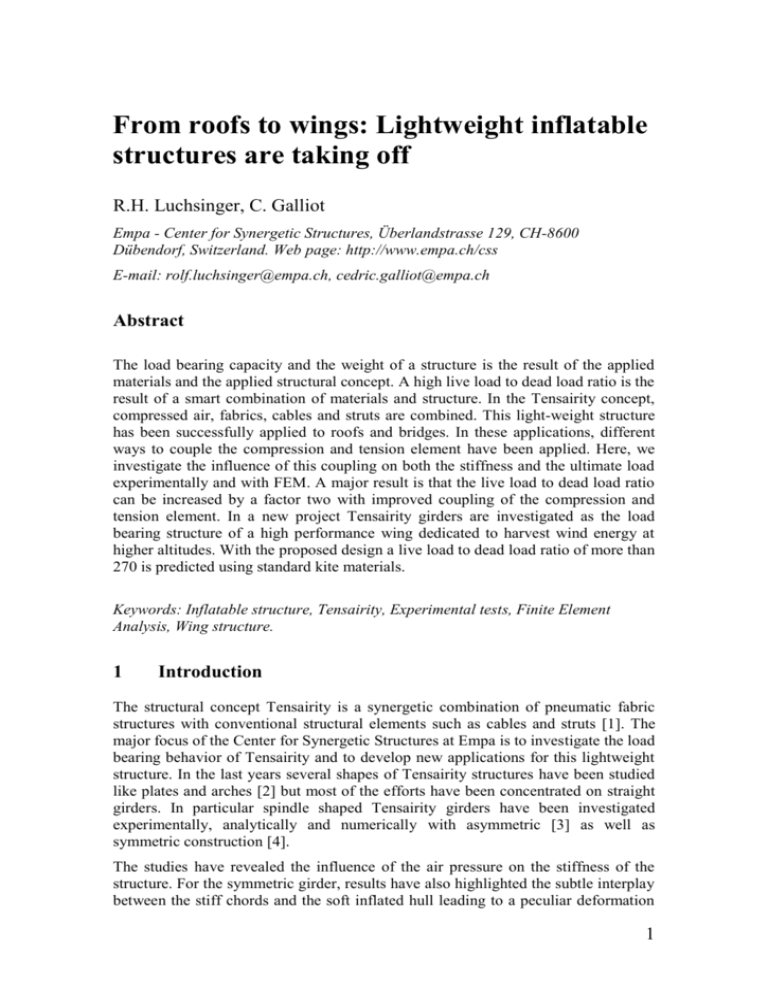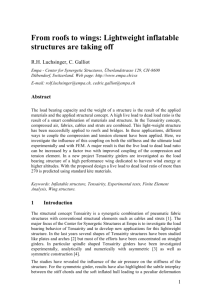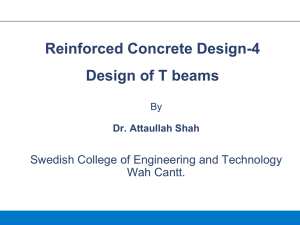TENSINET_EMPA_Final
advertisement

From roofs to wings: Lightweight inflatable structures are taking off R.H. Luchsinger, C. Galliot Empa - Center for Synergetic Structures, Überlandstrasse 129, CH-8600 Dübendorf, Switzerland. Web page: http://www.empa.ch/css E-mail: rolf.luchsinger@empa.ch, cedric.galliot@empa.ch Abstract The load bearing capacity and the weight of a structure is the result of the applied materials and the applied structural concept. A high live load to dead load ratio is the result of a smart combination of materials and structure. In the Tensairity concept, compressed air, fabrics, cables and struts are combined. This light-weight structure has been successfully applied to roofs and bridges. In these applications, different ways to couple the compression and tension element have been applied. Here, we investigate the influence of this coupling on both the stiffness and the ultimate load experimentally and with FEM. A major result is that the live load to dead load ratio can be increased by a factor two with improved coupling of the compression and tension element. In a new project Tensairity girders are investigated as the load bearing structure of a high performance wing dedicated to harvest wind energy at higher altitudes. With the proposed design a live load to dead load ratio of more than 270 is predicted using standard kite materials. Keywords: Inflatable structure, Tensairity, Experimental tests, Finite Element Analysis, Wing structure. 1 Introduction The structural concept Tensairity is a synergetic combination of pneumatic fabric structures with conventional structural elements such as cables and struts [1]. The major focus of the Center for Synergetic Structures at Empa is to investigate the load bearing behavior of Tensairity and to develop new applications for this lightweight structure. In the last years several shapes of Tensairity structures have been studied like plates and arches [2] but most of the efforts have been concentrated on straight girders. In particular spindle shaped Tensairity girders have been investigated experimentally, analytically and numerically with asymmetric [3] as well as symmetric construction [4]. The studies have revealed the influence of the air pressure on the stiffness of the structure. For the symmetric girder, results have also highlighted the subtle interplay between the stiff chords and the soft inflated hull leading to a peculiar deformation 1 of the system. The weak coupling between the tension and the compression chords has been emphasized. In this paper the influence of an improved coupling between the two struts is investigated experimentally and numerically for the same symmetric spindle-shaped Tensairity girder. The original girder is thereafter referenced as the o-spindle. Two modified Tensairity girders are studied that have the same chord geometry as the o-spindle but have in addition an improved coupling of the chords. The reinforcement of the c-spindle is a continuous fabric web while for the d-spindle it is discrete and given by a number of cables. These three designs have already been applied for the construction of roofs or bridges (Figure 1). Figure 1. Tensairity girders (from left to right): 8 m span bridge demonstrator (o-spindle), 10 m span ETH student project bridge (cspindle) and 28 m span roof over parking in Montreux (d-spindle). In a second part the design of a Tensairity beam for a high performance kite is presented. First investigations on the potential of Tensairity for kites have highlighted many advantages like the aerodynamic and structural performance, the low weight and the small storage volume [5]. In a new project, kites are developed at the Center for Synergetic Structures for harvesting wind energy at higher altitude. With the use of very light and strong materials the Tensairity technology can reveal its full potential in this application. 2 Design of symmetrical spindle shaped Tensairity girders The geometrical characteristics of the three Tensairity girders are shown in Figure 2. They are identical in the front view, with a span of 5 m and a maximal distance between the chords of 0.5 m at mid-span corresponding to a slenderness of 10. The parabolic chords are made of aluminum with a total cross section of 40 x 15 mm2. The end pieces connecting the upper and lower chords are made of steel. It is important that the support of the girder is located exactly at the theoretical intersection point of the lower and upper chord. The hulls including the web were fabricated using a PVC coated polyester fabric material (VALMEX 7318). Great care was taken that the fabric hull cannot move relative to the chords. To this end, a keder was welded to the hull as shown in the Detail B of Figure 2. The two halves of the chord are firmly clamped to the keder with a screw every 15 cm along the chord. The force which pre-stresses the web of the c-spindle is given by the hoop stress and depends on the air pressure, the radius of the hull segment and on the angle between the hull and the web. This angle was varied along the span of the c-spindle in order to obtain an equal pre-stress of the web. The pre-stress of the cables in the d-spindle depends on the geometry of the hull and the air pressure. The same hull geometry has been used for the c-spindle and d-spindle. Having a constant distance between 2 the cables, the same pretension in all cables can be obtained. In total 23 stainless steel wire ropes with 5 mm diameter each are used in the d–spindle. Figure 2. Tensairity spindles design. The total mass of the o-, c- and d-spindle is equal to 28.3 kg, 31.8 kg and 36.6 kg, respectively. They all share the same chords, end pieces and connectors that represent most of the system mass with 22.2 kg. As far as the hull is concerned, it weighs 6.1 kg for the o-spindle and about 8 kg for the reinforced girders. The ospindle is the lightest structure while the fabric web of the c-spindle increases the mass by about 12 %. The heaviest girder is the d-spindle. While the mass of all the cables is about the same as the mass of the web, two bladders needed to obtain an airtight structure as well as spacers and other small metallic parts needed for positioning the cables increase the total mass of the d-spindle by 4.8 kg compared to the c-spindle. 3 Testing and finite element analysis of the Tensairity girders A dedicated test rig was set up to test the load bearing behavior of the Tensairity girders (Figure 3). Two electromechanical drives with a maximal force of 20 kN each activate a whippletree system which distributes the load into 32 evenly spaced points. The simply supported girder is laterally supported in order to prevent out of plane movements under loading. The applied load is measured with load cells connecting the actuators with the whippletree system. Tests are displacement controlled. Three load cycles are applied. Deformation data of the girder are taken from the last cycle. The deformation of the girder is measured with a 3D digital image correlation system (Limess Vic 3D). To this end, several markers were placed along the chords of the test specimen to determine the deformation of the lower and upper chord along the span (Figure 4). A theoretical accuracy of about 0.1 mm (1/30 of a pixel) can be obtained with this system in this setting. Depending on the light conditions and the calibration a minimal accuracy of about 0.5 mm was obtained in practice. 3 Figure 3. Test rig for homogeneous distributed load. Figure 4. Test rig – position of the markers for 3D tracking of the displacement of the compression and tension members. Figure 5. Finite element models. 4 The Tensairity girders were modeled and analyzed with the finite element method using ANSYS. The steel end parts and the aluminum chords are modeled by 3D bricks and 2D shells, respectively. The membrane for the hull and the web are modeled with 2D shell elements without bending stiffness. The cables are modeled by 1D spar elements that have no bending stiffness and can only act under tension. The meshes are presented in Figure 4. The material properties of the coated fabric were obtained from in-house test procedures [6][7]. In addition a pressure-dependent shear modulus was used as significant variations can be observed in inflatable structures [8]. 4 Comparison between the Tensairity girders The measured and simulated displacement distributions along the span for the three girders for the compression member and the tension member are given in Figure 6. A distributed load of total 5000 N is applied. Obviously, the o-spindle deflects much more than the c- and d-spindle. The displacement of the compression element adopts an m-shape [4] with a maximal deflection at about 1.5 m from mid-span. This behavior must be attributed to the arched shape of the compression element as it was not found in the deflection behavior of an asymmetric o-spindle Tensairity girder with a straight compression element [3]. Interestingly, the tension chord moves against the direction of the applied load. This again can be attributed to the arched shape of the compression chord. As the rise of the compression member becomes smaller under the homogeneous loading, the ends connected with the tension member are pushed slightly outwards. This spreading of the system tends to straighten out the curved tension member leading to the observed displacement against the direction of the applied load. The overall behavior with a different displacement for the compression member and tension member indicates that the coupling between the chords is rather weak for the o-spindle. Figure 6. Deformation of the compression and tension members of the spindles under a distributed load of 5 kN at 25 kPa. The deflection of the compression member of the c-spindle also shows a slight mshape. However, the difference between the displacement at mid-span and the maximal displacement is small and close to the accuracy of the optical system. With a deflection of about 3 mm the c-spindle is much stiffer than the o-spindle. Both the 5 compression element and the tension element move in a very similar way in the direction of the applied load with a slightly larger displacement at the compression side where the load is being introduced. This proves that there is a much tighter coupling between the chords in the c-spindle than in the o-spindle due to the fabric web. In the case of the d-spindle, the maximal deflection is found at mid-span both for the compression and the tension member which have an almost identical displacement distribution. Again, as in the case for the c-spindle, a good coupling of the compression and tension member is obtained by the connecting cables. The deflection is about the same as for the c-spindle. Overall, it must be emphasized that the correlation between the experimental results and the FEA predictions is very good. The experimental load-displacement behavior of all three girders is shown in Figure 7 for two different pressures. Due to the particular deformation distribution of the ospindle the average displacement of the compression element over the entire span is shown on the x-axis in order to have a meaningful comparison. As already hinted in Figure 6, the c- and d-spindle perform much better than the o-spindle both in terms of stiffness and ultimate load. At 25 kPa for example the ultimate load is about a factor of two higher compared to the o-spindle, while the stiffness increases by about a factor of three due to the stronger coupling of the chords. Comparing the dspindle with the c-spindle, both the stiffness and the ultimate load are a bit higher for the d-spindle. Due to the higher mass of the d-spindle, the ratio of live load to dead load is about the same for the c-spindle and the d-spindle and in the order of 60 for the given pressure of 25 kPa. This ratio almost reaches 100 for a pressure of 50 kPa in some further tests. This is a dramatic improvement regarding the minute modifications introduced in these girders in comparison to the original o-spindle which reaches a live load to dead load ratio of only 54 for the same pressure. Figure 7. Experimental load displacement behaviour of the spindles under homogeneous distributed load for two hull pressures. The Figure 7 also emphasizes the influence of the air pressure in the hull. As the pressure increases the ultimate load increases for all three girders. For the o-spindle it has been shown that this influence is not linear and levels off at higher pressures [4]. For the c- and d-spindle however, the ultimate load is almost proportional to the pressure. For those girders, the ultimate load is reached when the fabric web or the 6 cables lose their pre-tension, which is indeed proportional to the pressure. Another interesting result is that the stiffness of the c- and d-spindle remains almost constant while the stiffness of the o-spindle significantly increases with the pressure. Actually, as long as the fabric web or the cables are under tension they act similarly to the web of a flanged beam whose flanges would be the chords. Therefore the stiffness of such girders can be roughly estimated using an equivalent I-beam model. These results will be discussed in more detail in an upcoming paper. Based on the comparison between the three girders under homogeneous distributed loading it appears that the c- and d-spindles are the most suitable Tensairity designs for roof or bridge structures as they allow for optimizing the live load to dead load ratio. The simpler design of the o-spindle makes it still very attractive for temporary applications. 5 Lightweight wing structures for airborne wind energy In order to satisfy the increasing demand for electric power as well as the CO2 emission reduction targets there is a growing need for sustainable energy production. Among the various renewable technologies wind has seen a dramatic development over the last twenty years. One major limitation of the wind turbines is however their tower height which strongly limits their potential. Generally, the wind speed increases with increasing altitude above ground. As the power density of the wind is proportional to the cube of the wind speed, harvesting higher altitude wind could significantly increase the energy production of the wind power systems. Today’s largest capacity wind turbines (>7 MW) have a hub height of about 130 m and reach a maximum height of about 200 m. In order to reach higher altitude, wind airborne wind energy concepts have been developed in the past decade [9]. One of these concepts is to use a kite or a tethered wing connected to a winch on the ground. Electrical energy is produced by transforming the linear aerodynamic lift force of the flying kite into a rotational motion of the winch. A closed-loop process is achieved by flying so called pumping cycles [10]. In the power phase, the kite flies crosswind generating high loads. The tether pulls on the drum which starts to rotate. The kite rises and the generator connected to the drum produces electrical power. Having reached a threshold altitude, the kite is flown out of the wind and the retraction phase starts. The kite is reeled in to a lower threshold altitude from where the power phase starts again. For this application the weight of the kite is a crucial topic to keep the kite airborne at low wind speed and to optimize the power production. Ideally, the mass per area of the wing is below 1 kg/m2. In addition, the wing load needs to be at least in the order of 50 kg/m2 in a kite power system which is equivalent to a live load to dead load ratio of 50. Using the Tensairity technology for the main structural element it is possible to design a lightweight wing that fulfills these requirements. In a previous project for example [5], a Tensairity kite has been designed that has a live load to dead load ratio of 40. The kite, presented in Figure 8, weighs 2.5 kg for an area of 11 m2 and can sustain a maximum of 1000 N of lift load. The design of the Tensairity beam should match the particular constraints due to the wing structure and the way it is attached. Contrary to roofs or bridges the beam is 7 not laterally supported and poorly constrained from the tether attachment. As a result the beam should have a quite high lateral stiffness in order to avoid any large out-of-plane deformations. Moreover if the wing has a constant cross section the beam must be cylindrical. In that case it turned out that a web construction was not as efficient as described in Sec. 4. Figure 8. Tensairity kite. Front view Symmetry plane Tether attachment point Wing Top view Bottom view Bottom rods (blue) Tethers Cables Beam position in the wing Cables Top rod (red) Cables Figure 9. Design of the kite main beam (half view). A new design has been proposed where two bended struts on the bottom side of the beam allow for improving the lateral stiffness of the beam (Figure 8). They are used as compression elements in the central part of the beam which is the mostly loaded. In fact the aerodynamic load is not constant over the span but rather follows an elliptical distribution. Another strut is located on top of the beam. It acts as a 8 compression element in the wing tips and also gives some stiffness to the beam in the direction opposite to the loading. The struts are connected together with cables. The beam is designed for a 4 m2 wing. It has a total span of 4.5 m, a diameter of 12 cm and the distance between the bridle attachment points is equal to 2.5 m. The diameter is here limited by the thickness of the wing profile. The struts are carbon composite pultruded tubes with a diameter of 6 mm on top and 8 mm at the bottom, both with a wall thickness of 1 mm. Cables are made of Dyneema and have a diameter of 4 mm. For the hull and the bladder, typical Nylon rip-stop and PU foil are used. The total mass of the beam is estimated to 760 g. An explicit quasi-static finite element analysis was performed with Abaqus. The hull is modeled with 2D membrane elements while the struts and the cables are modeled with 1D beam and 1D truss elements, respectively. The bladder is not modeled. The final mesh is presented in Figure 10. For an elliptical load distribution as shown in Figure 9 and a pressure of 30 kPa the maximum load is predicted to 2300 N. However the beam starts already to rotate around its axis and to buckle sideways for a total load of about 2050 N. This load is equivalent to a live load to dead load ratio of more than 270. The buckling load satisfies the target of loading of the wing which should support 50 kg/m2. The current wing has indeed a projected area of 4 m2 and therefore should carry about 2000 N. Figure 10. Kite main beam – finite element mesh and typical vertical deformation under a total of 1400 N. 6 Conclusion The role of a coupling between the compression and tension member in spindle shaped Tensairity girders under homogeneous distributed bending loads has been investigated. The coupling is accomplished either by a fabric web or by equidistant cables. Although it does increase the mass by only 12 to 30% it significantly increases the girder stiffness as well as its load bearing capacity. For example the results reveal an increase in stiffness of a factor three and an increase in ultimate load of a factor two at the given air pressure of 25 kPa. At a pressure of 50 kPa a live load to dead load ratio of about 100 has even been obtained. Therefore the cand d-spindle are particularly suitable for demanding applications like roof and bridge structures. A Tensairity beam design has been presented for the structure of a high performance wing dedicated to harvest high altitude wind energy. Using lightweight kite materials and a novel Tensairity construction enabling higher lateral stiffness, a live load to dead load ratio of more than 270 could be obtained for a pressure of 30 kPa. 9 The study reveals that different Tensairity concepts can be optimal depending on the structural problem to be solved. References [1] LUCHSINGER, R.H., PEDRETTI, A., STEINGRUBER, P., PEDRETTI, M. The new structural concept Tensairity: Basic Principles. ZIGONI, A. (Ed.), Progress in Structural Engineering, Mechanics and Computation, A.A. Balkema Publishers, London, 2004. [2] LUCHSINGER, R.H., ULMANN, C., CRETTOL, R., GAUTHIER, L.P. Straight and curved: Recent developments with Tensairity. BÖGNER-BALZ, H., MOLLAERT, M. (eds.), Tensile Architecture: Connecting Past and Future, Proceedings of the TensiNet Symposium 2010, TensiNet, Sofia, 2010, pp.95-102. [3] LUCHSINGER, R.H., SYDOW, A., CRETTOL, R. Structural behavior of asymmetric spindle-shaped Tensairity girders under bending loads. Thin-Walled Structures. Vol. 49, no. 9, 2011, pp. 1045-1053. [4] LUCHSINGER, R.H., GALLIOT, C. Structural behavior of symmetric spindle-shaped Tensairity girders. Journal of Structural Engineering, http://dx.doi.org/10.1061/(ASCE)ST.1943-541X.0000619. [5] BREUER, J.C.M., LUCHSINGER, R.H. Inflatable kites using the concept of Tensairity. Aerospace Science and Technology. Vol. 14, 2010, pp. 557-563. [6] GALLIOT, C., LUCHSINGER, R.H. A simple model describing the non-linear biaxial tensile behavior of PVC-coated polyester fabrics for use in finite element analysis. Composite Structures. Vol. 90, no. 4, 2009, pp. 438-447. [7] GALLIOT, C., LUCHSINGER, R.H. The shear ramp: a new test method for the investigation of coated fabric shear behavior - Part II: experimental validation. Composites Part A. Vol. 41, no. 12, 2010, pp. 1750-1759. [8] KABCHE, J.P., PETERSON, M.L., DAVIDS, W.G. Effect of inflation pressure on the constitutive response of coated woven fabrics used in airbeams. Composites Part B. Vol. 42, no. 3, 2011, pp. 526-537. [9] LOYD, M.L. Crosswind kite power. Journal of energy. Vol. 4, no. 3, 1980, pp. 106-111. [10] FAGIANO, L., MILANESE, M., PIGA, D. High-altitude wind power generation. IEEE Transactions on Energy Conversion. Vol. 25, no. 1, 2010, pp. 168-180. 10








